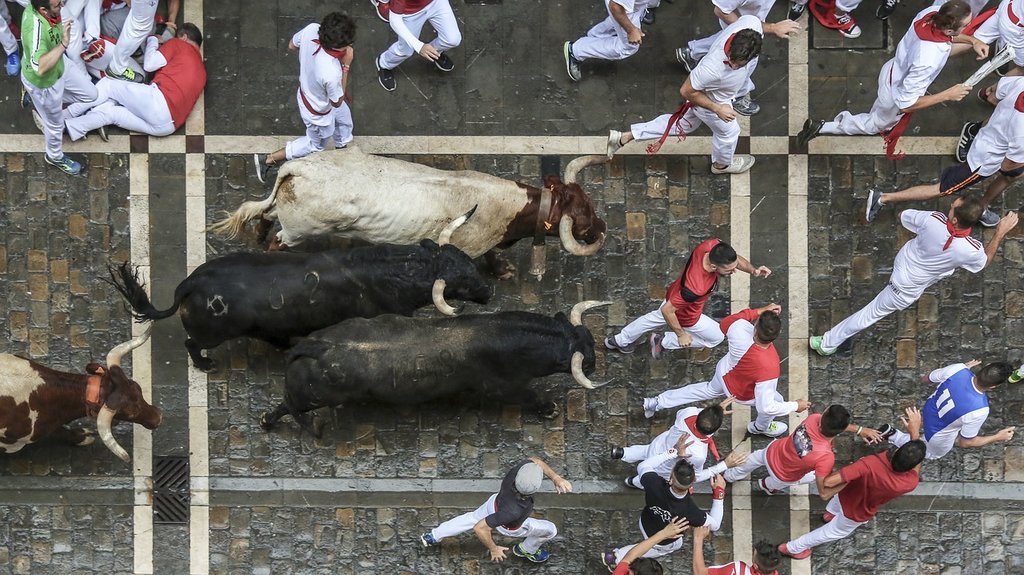Weather
Summer in Spain means one thing: heat. By July, Madrid will be hot and dry (temps push around 90°F/32°C), and many Madrileños will have abandoned the city for the relatively cooler climate on the coasts. If you do plan on touring the capital during this month, try to keep your daytime walking tours of the city to a minimum. The average high in popular coastal hotspots like Barcelona reach around 84°F (28°C), and it only gets hotter the further down the Mediterannean coast you travel. You'll find great weather on the northern Atlantic coast in Basque Country. In San Sebastián, for example, the average high is a perfect 73°F (22°C)
In Andalusia, temperatures are oppressive. The mercury regularly tops 100°F (37°C), and there's also a phenomenon called the Terral, a warm-weather front that starts blowing down the Mediterranean coast starting in July and hitting hard in August.
Crowds & Costs
This is the high season in Spain, so expect most places to be brimming with travelers, tourists, and holidaymakers. This can be a good thing, especially if you like a social party scene amid great crowds of people. This will be the case whether you're traveling to the Mediterranean coast, Ibiza, Barcelona, Mallorca, or anywhere else with long stretches of sand.
Of course, with the crowds come high prices on flights and hotels. For these reasons, we can't stress enough that if you're planning on visiting anywhere remotely popular in Spain that you make travel arrangements well in advance.
Where to Go
Many visitors to Spain look forward to visiting some of the historic and beautiful cities in the southwestern Andalusia region, like Málaga and Seville. For a beach holiday, you might want to stick to the popular areas further north like Valencia and Barcelona. But if you are determined to try and avoid the high-season crowds, there are some lesser-known beaches in Spain that might be more to your liking.
First, you can jet to the island of Menorca and visit Cala de Algaiarens, a beach with crystal-clear waters and golden sands nestled in a rocky cove. In the northwest of the country is Playa de Estorde, a long spit of fine white sand flanked by crystalline waters perfect for snorkeling. And if you happen to be on Ibiza and are looking for a respite from the party, visit Cala d'en Serra, a relatively peaceful beach hidden in a cove between two cliffs on the northwest side of the island.
Chat with a local specialist who can help organize your trip.
What to Do
The real question is what not to do. If you want culture, you can head to the north coast and visit the world-famous Guggenheim Museum in the city of Bilbao. Nearby you can (and should) sample the pintxos in San Sebastián. The historic center of this city is bursting at the seams with restaurants serving these tapas-like delicacies. You can also find great tapas culture in Barcelona and Andalusia.
Also, if you're traveling to Spain in the first couple weeks of the month, and you're interested in partaking in the biggest party in the country, then head straight to Pamplona, in the northeast of the country. That's where the bulls await (more on this below).
Events in July
Festival of San Fermín (Running of the Bulls), Pamplona. Each year from July 6 through the 14, Pamplona hosts this festival, which honors the patron saint of the city who was martyred in the 4th century.
But it's just how Pamplona celebrates San Fermín that has become the stuff of modern legend: mass crowds descend on the city as daredevils from all walks of life partake in a literal "running of the bulls." There are seven bulls total that snort and charge their way down the streets, and it's not uncommon for folks to get gored. Any danger is offset by copious drinking, dancing, and partying in the streets throughout the festival.
Traveling to Spain in July? Check out these great itineraries
Best of Barcelona & Ibiza - Days. For an unforgettable midsummer vacation, start in Barcelona, an enchanting European city that needs no introduction. Then jet off to the capital of cool—Ibiza island—for five days of white-sand beaches, sparkling seas, and serious relaxation.
Culinary Journey Through Spain - 12 Days. This food-forward tour starts with visits to an underwater winery and the Basque Culinary Center before moving on to La Rioja for wine tastings and vineyard tours. And summer is the perfect time to visit these vineyards.
More Helpful Tips
Spain in June
Spain in August
Best Time of Year to Visit Spain
How Many Days to Spend in Spain
